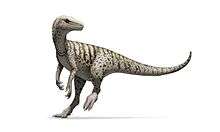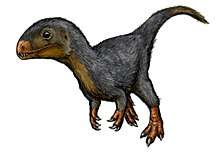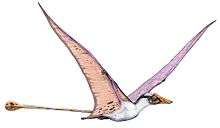Dracohors
| Dracohors | |
|---|---|
 | |
| Mounted skeleton of Asilisaurus, the oldest known dracohorsian. | |
| Scientific classification | |
| Kingdom: | Animalia |
| Phylum: | Chordata |
| Clade: | Dinosauriformes |
| Clade: | Dracohors Cau, 2018 |
| Subgroups | |
Dracohors is a clade of dinosauriform archosaurs that include dinosaurs and silesaurids.[1] The oldest known dracohorsian is Asilisaurus, dating to about 245 million years ago in the Anisian age of the middle Triassic period.[2] The synapomorphies of dracohorsians are according to Andrea Cau (2018):[1]
The anterior tympanic recess, the axial epipophyses, the centrodiapophyseal laminae in the presacral vertebrae, the relative size enlargement of the postacetabular process of ilium, the elongation of the pubis, the proximal sulcus and the reduction of the ligament tuber in the femoral head, and the further reduction in length of the fourth metatarsal and toe compared to the third.
Cau defined the group as the "most inclusive clade containing Megalosaurus bucklandii Mantell, 1827, but excluding Marasuchus lilloensis (Romer, 1971)."[1] A good consensus of phylogenetic work supports the sister grouping of silesaurids and dinosaurs[2][3][4], the interrelationships of dinosaurs has been debated. In particular the position of various Triassic dinosaurs such as Eodromaeus, Daemonosaurus, Pisanosaurus[5][6][7], and herrerasaurids[1][8], and the major dinosaur groups Sauropodomorpha, Theropoda, and Ornithischia.[9] The reason being is the taxon sampling size and the implications of how they affect the coding for the phylogenetic tree.[10] In his paper about the stepwise evolution of the avian bauplan, Cau (2018) found in the parsimony analysis polytomy between herrerasaur-grade taxa, Sauropodomorpha and the controversial Ornithoscelida. The Bayesian analysis, however, found a weak support in the sister grouping of a Dinosauria and Herrerasauria, but show strong support in the dictomy between Sauropodomorpha and Ornithoscelida as shown below:[1]
| Dracohors |
| |||||||||||||||||||||||||||||||||||||||||||||||||||
References
- 1 2 3 4 5 6 Andrea Cau (2018). "The assembly of the avian body plan: a 160-million-year long process" (PDF). Bollettino della Società Paleontologica Italiana. 57 (1): 1–25. doi:10.4435/BSPI.2018.01.
- 1 2 Nesbitt, S.J.; Sidor, C.A.; Irmis, R.B.; Angielczyk, K.D.; Smith, R.M.H.; Tsuji, L.M.A. (2010). "Ecologically distinct dinosaurian sister group shows early diversification of Ornithodira". Nature. 464 (7285): 95–98. doi:10.1038/nature08718. PMID 20203608.
- ↑ Langer, M.C., Ezcurra, M.D., Bittencourt, J.S., and Novas, F.E. (2010). "The origin and early evolution of dinosaurs". Biological Reviews 85:55-110. doi:10.1111/j.1469-185X.2009.00094.x
- ↑ Kammerer, C. F.; Nesbitt, S. J.; Shubin, N. H. (2012). "The First Silesaurid Dinosauriform from the Late Triassic of Morocco". Acta Palaeontologica Polonica. 57 (2): 277. doi:10.4202/app.2011.0015.
- 1 2 Agnolín, Federico L.; Rozadilla, Sebastián (2017). "Phylogenetic reassessment of Pisanosaurus mertii Casamiquela, 1967, a basal dinosauriform from the Late Triassic of Argentina". Journal of Systematic Palaeontology: 1–27. doi:10.1080/14772019.2017.1352623.
- ↑ Matthew G. Baron; David B. Norman; Paul M. Barrett (2017). "Baron et al. reply". Nature. 551 (7678): E4–E5. doi:10.1038/nature24012.
- ↑ Matthew G. Baron (2018). "Pisanosaurus mertii and the Triassic ornithischian crisis: could phylogeny offer a solution?". Historical Biology: An International Journal of Paleobiology. in press. doi:10.1080/08912963.2017.1410705.
- ↑ Matthew G. Baron; Megan E. Williams (2018). "A re-evaluation of the enigmatic dinosauriform Caseosaurus crosbyensis from the Late Triassic of Texas, USA and its implications for early dinosaur evolution". Acta Palaeontologica Polonica. in press. doi:10.4202/app.00372.2017.
- ↑ Baron, M.G., Norman, D.B., and Barrett, P.M. (2017). A new hypothesis of dinosaur relationships and early dinosaur evolution. Nature, 543: 501–506. doi:10.1038/nature21700
- ↑ Rodrigo Temp Müller; Sérgio Dias-da-Silva (2018). "Taxon sample and character coding deeply impact unstable branches in phylogenetic trees of dinosaurs". Historical Biology: An International Journal of Paleobiology. in press. doi:10.1080/08912963.2017.1418341.






